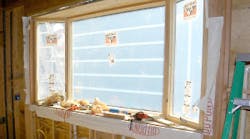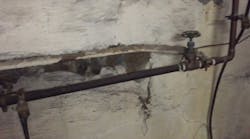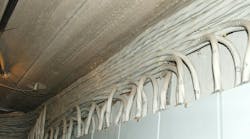This rough-in inspection creates the starting point for an interesting discussion. The concern for receptacles at countertops in residential occupancies is based on the fact that a modern kitchen now has a variety of cord- and plug-connected appliances. The Code mandates receptacle outlets be installed so that “no point along the wall is more than 600 mm (24 in.) measured horizontally from a receptacle outlet.” But as you can clearly see in the photo, there are no outlet boxes installed on the wall directly behind the full length of this large kitchen window. So one might assume this is clearly a violation of NEC requirements. But does this really constitute a Code violation? I would rule it does not.
First, the rule of part (C)(4) in 210.52 indicates that sinks essentially break countertops into separate pieces. In addition, the rule given in the Exception to 210.52(C)(1) says, “Receptacle outlets shall not be required on a wall directly behind a range, counter-mounted cooking unit or sink in the installation described in Figure 210.52(C)(1).” However, in a backward fashion, this Exception would require a receptacle behind the sink area if the amount of counter space located directly behind the sink was as described in the Figure. So the key question for us here is, “Does this Exception apply to the installation shown in the photo?” I say no, for two reasons.
First, the basic rule and the Exception to 210.52(C)(1) refer to installation of receptacle outlets in the “wall counter space.” Because there is no “wall” directly behind the sink, it seems that this installation would be excluded from the need for an outlet there. Second, even though the bay window's ledge may end up being greater than the 12-in. or 18-in. distance specified in the Exception to 210.52(C)(1), the window's ledge is not actually considered counter space. Because the rules in this part of 210.52 apply to countertops — and the final installation won't have counter space that is greater than the 12-in. or 18-in. criteria specified in the Exception — it seems reasonable to conclude this is not one of those instances where an outlet would be required behind the sink.




